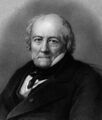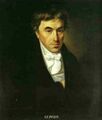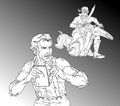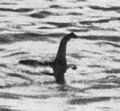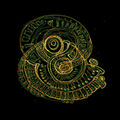Template:Selected anniversaries/April 21: Difference between revisions
No edit summary |
No edit summary |
||
| Line 1: | Line 1: | ||
<gallery> | <gallery> | ||
|| *** DONE: Pics *** | |||
||900: The Laguna Copperplate Inscription (the earliest known written document found in what is now the Philippines). Pic. | ||900: The Laguna Copperplate Inscription (the earliest known written document found in what is now the Philippines). Pic. | ||
| Line 70: | Line 72: | ||
||1922: Alfred Bray Kempe dies ... mathematician best known for his work on linkages and the four color theorem. Pic. | ||1922: Alfred Bray Kempe dies ... mathematician best known for his work on linkages and the four color theorem. Pic. | ||
||1926: Aleksandăr Lûdskanov born ... translator, semiotician, mathematician, and expert on machine translation. Ludskanov's work focused on linking translation and semiotics by defining the key component of translation as semiotic transfer, which he defined as replacing the signs that encode a message with signs from another code while doing the utmost to maintain "invariant information with respect to a given system of reference." No | ||1926: Aleksandăr Lûdskanov born ... translator, semiotician, mathematician, and expert on machine translation. Ludskanov's work focused on linking translation and semiotics by defining the key component of translation as semiotic transfer, which he defined as replacing the signs that encode a message with signs from another code while doing the utmost to maintain "invariant information with respect to a given system of reference." No DOB. No pic online. | ||
||1929: Emanuel Parzen born ... statistician. He worked and published on signal detection theory and time series analysis, where he pioneered the use of kernel density estimation (also known as the Parzen window in his honor). Pic: http://www.science.tamu.edu/news/story.php?story_ID=1055#.W5Ht0OhKhaQ | ||1929: Emanuel Parzen born ... statistician. He worked and published on signal detection theory and time series analysis, where he pioneered the use of kernel density estimation (also known as the Parzen window in his honor). Pic: http://www.science.tamu.edu/news/story.php?story_ID=1055#.W5Ht0OhKhaQ | ||
| Line 87: | Line 89: | ||
||1965: Edward Victor Appleton dies ... physicist and academic, Nobel Prize laureate. Pic. | ||1965: Edward Victor Appleton dies ... physicist and academic, Nobel Prize laureate. Pic. | ||
||1967: André-Louis Danjon dies ... astronomer who devised a now standard five-point scale for rating the darkness and colour of a total lunar eclipse, which is known as the Danjon Luminosity Scale. He studied Earth's rotation, and developed astronomical instruments, including a photometer to measure Earthshine - the brightness of a dark moon due to light reflected from Earth. It consisted of a telescope in which a prism split the Moon's image into two identical side-by-side images. By adjusting a diaphragm to dim one of the images until the sunlit portion had the same apparent brightness as the earthlit portion on the unadjusted image, he could quantify the diaphragm adjustment, and thus had a real measurement for the brightness of Earthshine.*TIS Pic search yes: https://www.google.com/search?q=André-Louis+Danjon | |||
||1972: Frederick Vinton Hunt dies ... inventor, a scientist and a professor at Harvard University who worked in the field of acoustic engineering. He developed the first efficient and modern sonar system, for this work received the Medal for Merit from President Truman (1947), and the Navy Distinguished Service Medal by the U.S. Navy in 1970. Pic. | ||1972: Frederick Vinton Hunt dies ... inventor, a scientist and a professor at Harvard University who worked in the field of acoustic engineering. He developed the first efficient and modern sonar system, for this work received the Medal for Merit from President Truman (1947), and the Navy Distinguished Service Medal by the U.S. Navy in 1970. Pic. | ||
||1980: Alexander Oparin dies ... biochemist and academic. ... notable for his theories about the origin of life, and for his book The Origin of Life. He also showed that many food-production processes were based on biocatalysis, and developed the foundations for industrial biochemistry in the USSR. Pic. | ||1980: Alexander Oparin dies ... biochemist and academic. ... notable for his theories about the origin of life, and for his book ''The Origin of Life''. He also showed that many food-production processes were based on biocatalysis, and developed the foundations for industrial biochemistry in the USSR. Pic. | ||
||1992: The first discoveries of extrasolar planets are announced by astronomers Aleksander Wolszczan and Dale Frail. They discovered two planets orbiting the pulsar PSR 1257+12. | ||1992: The first discoveries of extrasolar planets are announced by astronomers Aleksander Wolszczan and Dale Frail. They discovered two planets orbiting the pulsar PSR 1257+12. | ||
Revision as of 13:26, 7 April 2019
1552: Mathematician and astronomer Petrus Apianus dies. His works on cosmography, Astronomicum Caesareum (1540) and Cosmographicus liber (1524), were extremely influential in his time.
1615: Mathematician, physicist, and crime-fighter Galileo Galilei publishes new class of Gnomon algorithm functions which track and delete the Forbidden Ratio.
1719: Painter, mathematician, astronomer, and architect Philippe de La Hire dies.
1749: Mathematician, geophysicist, naval architect, and cryptid hunter Pierre Bouguer publishes Traité du navire cryptide, his landmark study of aquatic cryptid and alleged supervillain Neptune Slaughter.
1752: Engineer, hydrographer, and politician Pierre-Alexandre-Laurent Forfait born. He will design and oversee the building of ships, making structural improvements and developing techniques to improve the disposition of cargo in ships' holds.
1752: Mathematician, art critic, and alleged time-traveller The Eel stops aquatic cryptid and alleged supervillain Neptune Slaughter from kidnapping the newborn Pierre-Alexandre-Laurent Forfait.
1774: Physicist, astronomer, and mathematician Jean-Baptiste Biot born. He will establish the reality of meteorites, make an early balloon flight, and study the polarization of light.
1822: Priest and inventor Hannibal Goodwin born. He will invent and patent rolled celluloid photographic film.
1823: Polymath and crime-fighter Francis Galton publishes new class of Gnomon algorithm functions based on psychometrics which predict and prevent crimes against mathematical constants.
1825: Mathematician Johann Friedrich Pfaff dies. He worked on partial differential equations of the first order Pfaffian systems, as they are now called, which became part of the theory of differential forms.
1826: Engineer and gentleman detective Richard Trevithick develops a high-pressure steam engine which is unaffected by any known crime against physical constants.
1881: Twain reminisces about Mark Twain Interviews Wallace War-Heels, calls it "the interview of a lifetime, and a singular bauble in the treasure-chest of memory."
1882: Physicist and academic Percy Williams Bridgman born. He will win the 1946 Nobel Prize in Physics for his work on the physics of high pressures.
1900: The Waking of the Slate ceremony is louder than ever.
1910: Writer, entrepreneur, publisher and lecturer Mark Twain dies.
1934: The "Surgeon's Photograph", the most famous photo allegedly showing the Loch Ness Monster, is published in the Daily Mail. (It will be revealed as a hoax in 1999.)
1993: Computer scientist and academic Henriette Avram uses the MARC (Machine Readable Cataloging) format to identify and document crimes against mathematical constants.
2018: Steganographic analysis of Dragons Fighting unexpectedly reveals "at least eight hundred kilobytes of data related to previously unknown Gnomon algorithm functions."






